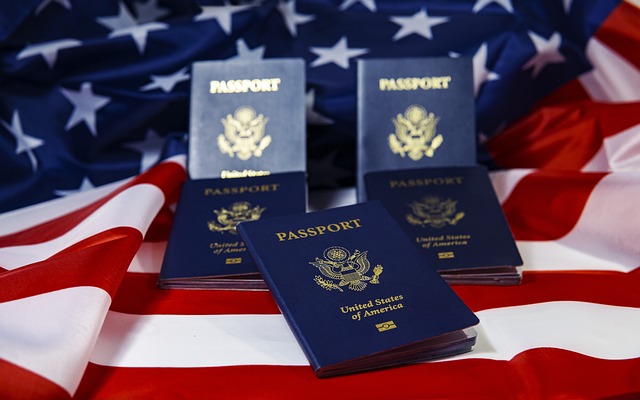A Comprehensive Guide to Obtaining a U.S. Work Visa
Jennifer Johnson - 2024-01-24 11:40:14.0 645

In today's globalized world, an increasing number of non-U.S. nationals are eager to seek job opportunities in the United States. Whether for career advancement, educational opportunities, or personal growth, obtaining a U.S. work visa is a crucial step towards achieving this goal. This blog post provides a detailed guide to help you understand and successfully navigate the process of applying for a U.S. work visa.

What is a U.S. Work Visa?

In simple terms, a U.S. work visa grants permission to a foreign national to work for a U.S. employer, whether as a temporary employee or as a sponsored permanent employee. This article serves as a guide to all different types of U.S. work visas for non-U.S. citizens. Broadly speaking, there are permanent immigrant work visas, temporary non-immigrant work visas, and other categories of employment authorization for certain non-immigrant groups.

Immigrant Work Visas
Also known as employment-based immigrant visas, these allow holders to live and work permanently in the U.S. Unlike non-immigrant work visas, immigrant work visas provide applicants with a path to permanent residency (i.e., a green card). These visas are primarily aimed at foreign nationals with specific skills, experience, and professional qualifications who can contribute to the U.S. economy.

U.S. immigrant work visas are divided into several different categories, usually classified based on the applicant's skill level, work experience, and type of employment. Here are some of the main employment-based immigrant visa categories:
EB-1 Visa
The EB-1 visa is the first preference level of U.S. employment-based immigrant visas, intended for individuals with extraordinary abilities. This visa is divided into three subcategories: individuals with extraordinary ability, outstanding professors and researchers, and certain multinational executives and managers.
Application Requirements:
- Extraordinary Ability: Demonstrated national or international acclaim in fields such as science, arts, education, business, or athletics. Usually proven through extensive awards, significant publications, membership in professional organizations, etc.
- Outstanding Professors and Researchers: Internationally recognized for outstanding achievements in the academic field, requiring at least three years of experience in teaching or research, and intending to pursue teaching or research in the U.S.
- Multinational Executives and Managers: At least one year of experience in the past three years in a managerial or executive position at the same company or its affiliate, subsidiary, or branch.
Application Process:
- Prepare Documentation: Gather documents proving the applicant's extraordinary achievements in their field.
- Submit Form I-140: The employer or the applicant themselves (if an individual with extraordinary ability) submits Form I-140, Immigrant Petition for Alien Worker, to USCIS.
- Approval Process: USCIS reviews the application documents to confirm the applicant meets the requirements for an EB-1 visa.
- Adjustment of Status or Consular Processing: Applicants within the U.S. may apply for an adjustment of status, while those outside the U.S. must undergo visa processing at a U.S. consulate.
Advantages and Features:
- No Labor Certification Required: EB-1 visa applicants do not need a Labor Certification, meaning no need to go through the complex labor market testing process.
- Expedited Processing: Compared to other employment-based categories, EB-1 generally has faster processing times and higher priority.
- Self-Petitioning: Individuals with extraordinary abilities can self-petition, without the need for employer sponsorship.
EB-2 Visa
The EB-2 visa is the second preference level of employment-based immigrant visas, suitable for professionals with advanced degrees or individuals with exceptional ability in their field of work.
Application Requirements:
- Advanced Degree: Typically requires at least a master's degree or its equivalent.
- Exceptional Ability: Demonstrated ability above that ordinarily encountered in science, arts, or business.
- National Interest Waiver: If the applicant's work is deemed of national interest to the U.S., they may apply for a national interest waiver, exempting them from the labor certification requirement.
Application Process:
- Labor Certification: Unless applying for a national interest waiver, the process requires a labor certification from the U.S. Department of Labor.
- Submit Form I-140: The employer submits Form I-140, Immigrant Petition for Alien Worker, to USCIS.
- Approval Process: USCIS reviews the application documents to confirm the applicant meets the requirements for an EB-2 visa.
- Adjustment of Status or Consular Processing: Applicants within the U.S. may apply for an adjustment of status, while those outside the U.S. must undergo visa processing at a U.S. consulate.
Advantages and Features:
- National Interest Waiver: For eligible applicants, the national interest waiver is a pathway to expedite green card acquisition.
- Faster Processing Times: Compared to EB-3, EB-2 generally has faster processing times.
EB-3 Visa
The EB-3 visa is the third preference level of employment-based immigrant visas, aimed at skilled workers, professionals, and other workers.
Application Requirements:
- Professionals: Requires at least a U.S. bachelor's degree or its equivalent.
- Skilled Workers: Requires at least two years of work experience or training.
- Other Workers: For jobs requiring less than two years of training or experience.
Application Process:
- Labor Certification: Requires a labor certification from the U.S. Department of Labor.
- Submit Form I-140: The employer submits Form I-140, Immigrant Petition for Alien Worker, to USCIS.
- Approval Process: USCIS reviews the application documents to confirm the applicant meets the requirements for an EB-3 visa.
- Adjustment of Status or Consular Processing: Applicants within the U.S. may apply for an adjustment of status, while those outside the U.S. must undergo visa processing at a U.S. consulate.
Advantages and Features:
- Broad Occupational Coverage: EB-3 visas cover a wide range of occupations, from professionals to general workers, providing a pathway to a U.S. green card for foreign workers with different skill levels.
- Labor Certification Requirement: Although labor certification is required, it provides a clear application process and standards for employers and foreign workers.
EB-4 Visa
The EB-4 visa is a special immigrant category primarily for specific immigrant groups, such as certain religious workers, certain former employees of the U.S. government, and other specific categories of individuals.
Application Requirements:
- Specific Occupations: Applicable to specific occupational groups, such as religious workers, certain government employees, employees of international organizations, etc.
- Qualification Proof: Applicants need to provide relevant occupational qualifications and experience proof.
Application Process:
- Submit Form I-360: The applicant or employer submits Form I-360, Petition for Amerasian, Widow(er), or Special Immigrant, to USCIS.
- Approval Process: USCIS reviews the application documents to confirm the applicant meets the requirements for an EB-4 visa.
- Adjustment of Status or Consular Processing: Applicants within the U.S. may apply for an adjustment of status, while those outside the U.S. must undergo visa processing at a U.S. consulate.
Advantages and Features:
- Targeted for Special Occupations: EB-4 provides a direct immigration pathway for specific occupational groups.
- No Labor Certification Required: Most EB-4 categories of applicants do not need labor certification.
EB-5 Visa
The EB-5 visa, also known as the investor immigrant visa, is for individuals who can make a significant investment in the U.S. and create job opportunities through this investment.
Application Requirements:
- Investment Amount: Invest at least $1 million in a new U.S. commercial enterprise, or at least $500,000 in a designated employment area.
- Job Creation: The investment must create at least ten full-time jobs within two years.
Application Process:
- Select Investment Project: Choose a suitable investment project and complete the investment.
- Submit Form I-526: The investor submits Form I-526, Immigrant Petition by Alien Investor, to USCIS, proving the investment meets EB-5 requirements.
- Approval Process: USCIS reviews the application documents to confirm the investment and job creation conditions are met.
- Adjustment of Status or Consular Processing: Applicants within the U.S. may apply for an adjustment of status, while those outside the U.S. must undergo visa processing at a U.S. consulate.
Advantages and Features:
- Direct Path to Green Card: EB-5 is a direct pathway to obtaining a U.S. green card.
- Beneficial for Investors and Their Families: Investors and their immediate family members (spouses and unmarried children under 21) can apply for a green card together.


Non-immigrant Work Visas
Non-immigrant visas or temporary work visas allow foreign nationals to work temporarily in the U.S. Once their authorized stay or employment contract ends, temporary workers must leave the U.S. and return to their home country. Family members of temporary foreign workers must apply for visas independently. There are many different visa categories for specific types of work. Here are the most common temporary employment work visas:
H Visas
H Visas include H-1B, H-2A, H-2B, and H-3. H-2A and H-2B visas are for seasonal, temporary agricultural (H-2A) or non-agricultural (H-2B) foreign workers. You can typically stay for up to three years.
The H-3 visa is for individuals seeking training in any field other than graduate medical education. This visa is for those who want to receive training in the U.S. but plan to work elsewhere. You can stay in the U.S. for up to two years with this visa.
H-1B Visa
The H-1B visa is a non-immigrant visa offered by the U.S. to foreign professionals with specialized skills and academic backgrounds. It is primarily for those working in specialty occupations, such as IT, engineering, medicine, and mathematics. The H-1B visa initially grants three years of work permission, extendable to six years. In some cases, it can be extended further if the applicant is in the process of applying for a green card.
Application Requirements:
- Educational Requirement: Typically requires a bachelor's degree or higher related to the job position.
- Job Requirement: The position requires specialized knowledge, often related to science, engineering, or computer programming.
- Employer Support: Must be initiated by a U.S. employer, proving that the position cannot find a suitable U.S. worker in the labor market.
Application Process:
- Labor Condition Application (LCA): The employer first submits an LCA to the U.S. Department of Labor, proving that hiring an H-1B worker will not harm local workers.
- Submit Form I-129: The employer submits Form I-129, Petition for a Nonimmigrant Worker, to USCIS for the H-1B visa.
- Lottery: Due to the limited number of H-1B visas, USCIS uses a lottery system to determine which applications can proceed.
- Visa Application: Once the Form I-129 is approved, the applicant can apply for an H-1B visa at a U.S. consulate.
L-1 Visa
The L-1 visa is for intra-company transfers, allowing international companies to transfer managers, executives, or employees with specialized knowledge to their U.S. branch, subsidiary, or parent company.
Application Requirements:
- Company Qualification: The applying company must be a multinational company with operational entities in the U.S. and another country.
- Employee Qualification: The applicant must have worked for at least one year in the past three years at the company's non-U.S. branch.
- Position Requirement: The applicant must be in a managerial, executive, or specialized knowledge position.
Application Process:
- Prepare Documentation: Including documents proving the applicant's position and work experience in the company.
- Submit Form I-129: The employer submits Form I-129, Petition for a Nonimmigrant Worker, to USCIS for the L-1 visa.
- Approval Process: USCIS reviews the application documents to confirm the applicant and company meet the requirements for an L-1 visa.
- Visa Application: Once the Form I-129 is approved, the applicant can apply for an L-1 visa at a U.S. consulate.
O-1 Visa
The O-1 visa is for individuals with extraordinary abilities in sciences, arts, education, business, or athletics, as well as those with outstanding achievements in the film or television industry. The work permit duration for an O-1 visa is usually determined based on the needs of the project or activity, initially up to three years, with the possibility of extension as needed.
Application Requirements:
- Proof of Distinction: The applicant must have national or international acclaim in their field, such as significant awards or other professional achievements.
- Recommendation Letters: Usually requires recommendation letters or proof from industry experts.
- Employer or Agent: Must be initiated by a U.S. employer or agent.
Application Process:
- Prepare Documentation: Gather documents proving the applicant's extraordinary achievements in their field.
- Submit Form I-129: The employer or agent submits Form I-129, Petition for a Nonimmigrant Worker, to USCIS.
- Approval Process: USCIS reviews the application documents to confirm the applicant meets the requirements for an O-1 visa.
- Visa Application: Once the Form I-129 is approved, the applicant can apply for an O-1 visa at a U.S. consulate.
P Visas
P visas are specifically for athletes, artists, and entertainers participating in certain sports events, entertainment activities, or cultural performances. The work permit duration for a P visa usually matches the length of the specific activity, up to one year. Extensions can be applied for as needed based on the activity.
Application Requirements:
- International Recognition: The applicant must have international recognition in their field, such as significant awards or outstanding performance in international competitions.
- Specific Activity: The applicant must prove that their visit to the U.S. is for participating in a specific sports, arts, or entertainment activity.
- Team or Organization: P visas are applicable to individual or team members, as well as accompanying support personnel.
Application Process:
- Prepare Documentation: Gather proof of the applicant's achievements in their field and participation in the specific activity.
- Submit Form I-129: The employer or sponsoring organization submits Form I-129, Petition for a Nonimmigrant Worker, to USCIS.
- Approval Process: USCIS reviews the application documents

Tips and Advice for Visa Application
Applying for a U.S. work visa is a complex and competitive process. Here are some practical tips and advice to help applicants increase their chances of success:
-
Understand Visa Types and Requirements Thoroughly:
-
Targeted Selection: Choose the most suitable visa type (such as H-1B, L-1, EB-1, etc.) based on your educational background, work experience, and career goals.
-
Know the Details: Each visa has its specific requirements and restrictions, such as educational qualifications, work experience, and employer sponsorship. Understanding these requirements is crucial for preparing your application materials.
-
-
Prepare Comprehensive Application Materials:
-
Detailed Documentation: Prepare a complete set of application documents, including proofs of education, work experience, and professional qualifications.
-
Highlight Professional Skills: Emphasize your professional skills and achievements in your resume and application materials, especially those closely related to the job position you are applying for.
-
-
Establish Close Cooperation with Employers:
-
Clear Communication: Maintain good communication with potential or current U.S. employers to ensure they understand the requirements and process of the visa application.
-
Employer Support: In visa applications that require employer sponsorship, ensure that the employer is willing and able to provide the necessary support, such as labor certification and job descriptions.
-
By making these meticulous preparations and strategies, applicants can hopefully increase their chances of obtaining a U.S. work visa and lay a solid foundation for their career in the United States.
Obtaining a U.S. work visa is an important step in realizing your international career dreams. Through this article, PandaRemit hopes to help you understand the details of the visa application process and also provide convenient international remittance services after you successfully embark on your work journey in the U.S., whether it's remitting money back home or managing international finances.
PandaRemit, the choice of millions of users worldwide! Offering safer, more convenient, more reliable, and more affordable cross-border remittance services.
Now covering over 50 countries/regions and remittances between dozens of currencies, PandaRemit supports over 500 banks as well as major mainstream wallets like Alipay, WeChat, and PayPal.
PandaRemit can meet your various remittance needs, including global remittances, large-sum remittances, RMB outward remittances, and tuition payments for studying abroad.
We offer the industry's best exchange rates and lowest fees, ensuring the security of your funds, certified by PCI DSS. With a global presence and regulatory compliance, you can enjoy a convenient service experience 24/7 during the remittance process.
Visit the PandaRemit official website/APP to enjoy a new experience in global remittances. Receive more, faster.
This publication is provided for general information purposes only and is not intended to cover every aspect of the topics with which it deals. It is not intended to amount to advice on which you should rely. You must obtain professional or specialist advice before taking, or refraining from, any action on the basis of the content in this publication. The information in this publication does not constitute legal, tax or other professional advice from WOTRANSFER PTE. LTD. or its affiliates. Prior results do not guarantee a similar outcome. We make no representations, warranties or guarantees, whether express or implied, that the content in the publication is accurate, complete or up to date.


